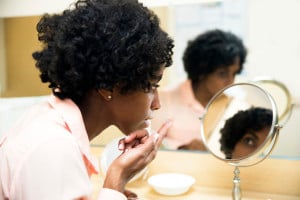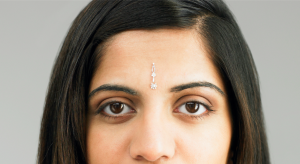Growing up, I remember thinking I was only allowed to be attracted to and in relationships with men of color. It’s not like I had a problem with that, it just seemed like an unspoken rule.
It wasn’t often that I saw a white men and boys look at a women and girls of color in the same way they looked at white women. So when I became attracted to a white boy in middle school, I didn’t know how to approach the situation.
In my brave attempt to connect with my crush, I wrote him what I thought would be a private note. I quickly realized that he lacked integrity and was not someone to be vulnerable with when he and his friends began pointing and whispering names at me every time I passed them.
That experience was traumatizing because of the way it made me feel so unattractive and unworthy of this boy’s attention.
Although this is something many young girls go through, the fact that I was a girl of color made this experience a little different. I didn’t just feel unattractive, I felt unattractive because he was white and I wasn’t and I felt that was the reason why he didn’t like me.
I felt not being white was what made me not pretty.
Whether my race was a factor or not doesn’t really matter now.
The point is from that moment and probably even before that point, I based my desirability and worth according to how I thought white men responded to me — I didn’t yet realize it, but I was subtly being shaped by white supremacy in the form of the white male gaze.
Laura Mulvey first coined the term male gaze in 1975. It was a term she used to analyze the portrayal of women specifically in cinema. She explains how cinema portrays women as passive subjects existing for the viewing pleasure of the male spectator.
What this male gaze does in cinema is objectify women and deprive them of their sexual agency, but it can also be applied to other visual mediums including television and the fine arts.
The white male gaze goes a step further and complicates this theory by acknowledging that race makes the experience of objectification different for WoC. This is because although all women are objectified in media, whiteness is idealized in a way that celebrates the beauty of white women in a way WoC are not.
The male gaze is part of a patriarchal system that is not only white, but also cis and heterosexual.
It determines who is desirable and pleasurable to look at and who we should aspire to be based on the messages we receive from the media.
With the way white women are idealized in the media it is not really surprising WoC learn from a young age that in order to be attractive they have to strive to look more white or at least perpetuate the stereotypes about WoC that are appreciated by the white male gaze.
This white male gaze has an affect on how we define our sexuality and how we express ourselves. It also has an affect on our self-esteem and self-worth.
Although I don’t want to minimize the affects the male gaze has on all women, I do want to emphasize that the way WoC are affected by the white male gaze is different in the following unique ways.
1. It Limits Desirability Based On Race
I love the song Beautiful by Christina Aguilera, but every time I listen to it I feel a little bitter. Why? Because watching the music video for the first time as a kid the message was lost on me.
Instead of focusing on the awesome message I kept telling myself that although I was beautiful, I would never be Christina Aguilera beautiful. Easy for her to say we are all beautiful when there is no denying her beauty.
On a daily basis women of color are told they are not the ideal or the conventional beauty standard.
We see it in magazines that feature a white woman who they tell us is the most beautiful woman in the world. If a woman of color is featured, her skin has been lightened to the lightest shade possible that will still allow us to recognize her at second glance.
Most of these messages we receive from media are rooted in the racialization of beauty and of desirability and have been around for a very long time.
These messages were visible in our portrayals within classic Hollywood cinema on the rare occasion we were portrayed at all. Today we see it in the way WoC and white women are positioned next to each other when they occupy the same space on screen.
Basically, WoC who play an often-secondary role next to the lead white counterpart are only there for comic relief or to perpetuate well-known racial stereotypes. These characters are also much less complex than their white counterparts. The most recent example of this being Hot Pursuit (2015).
All of this works against us by pinning women against each other and making it difficult to see past perceptions of inferiority. This is what makes those of us who are proud of the way we look stand out. It’s the sad assumption that we are being brave for loving ourselves because our beauty is labeled unique but not ideal.
Seriously?! We are not being brave for liking the way we look — If anything, we are being enlightened.
Why?
Because we are acknowledging the dangers of seeking affirmation from and striving to appeal to the white male gaze. Determining our own worth means taking back some of that power and diminishing beliefs that our worth is directly linked to our bodies or to the oppressive ideals of a patriarchal and misogynistic system.
2. It Objectifies And Makes A Spectacle Of The Bodies Of WoC
Although the male gaze objectifies women as a whole, there is a difference in how WoC are objectified that suggests inferiority. Not only are we objectified, exotified, and hypersexualized, but we are also portrayed as spectacles solely to be looked at and this minimizes our worth.
There are many current examples of how society has turned our bodies into spectacles, but one of the earliest examples of this is the story of Saartjie Baartman… a name we should all know but don’t. Saartjie was a Khoikhoi woman from South Africa who was sold to a European doctor in the 19th century.
She was brought to Europe in her 20’s and exploited for her large butt. She was made to perform for European audiences who ridiculed her. After the death of the European doctor she went to Paris where she performed in shows and was subjected to examinations by an anatomy doctor.
Saartjie died in 1815 after living a life of poverty in a society that made a spectacle of her body so much so that the objectification continued even after death — her remains were exhibited in a museum until 1975 when she was finally laid to rest.
What Saartjie experienced was in contrast with the way the bodies of white women were treated. The bodies of white women during this time were considered sacred and expected to be completely covered up in public. They were seen as docile, pure, and asexual beings at the same time that WoC where being objectified and hypersexualized.
This relates to the white male gaze because it was the dominant views of white men at the time that both colonized our bodies while also possessing the bodies of white women by keeping them covered up and taking away their sexual agency.
The dominant white male gaze was and is still determining our worth today.
The way we are portrayed in the media makes a spectacle out of our physical attributes and limits our worth to sexual relationships rather than portray us in more complex and meaningful relationships.
This becomes a problem when these portrayals affect the relationships we have with men in real life.
For example, I’ll never forget the time a white man who was in a relationship with a white woman told me he always wanted to have sex with a black girl. In his mind, white women where meant for more meaningful relationships, but WoC were meant for sexual experimentation.
I’m not saying that strictly sexual relationships are meaningless or that marriage makes a relationship more meaningful, but when we are expected to only have these types of relationships based on perceptions about our sexuality and objectification of our bodies, that is a problem.
3. It Aims To Regulate Self-Expression And Attempts To Define The Sexuality Of WoC
As a Latina woman, the most common criticism I heard growing up against women who appeared to be overtly sexual was epitomized in the phrase “mira que fresca” meaning, “look at how fresh she is.” Consequently, I definitely didn’t want to appear fresh because being fresh meant I was purposely flaunting my sexuality around and that was just not something to be proud of.
Now I realize the reason why Latina women are warned to avoid actions that would cause us to be labeled “fresca” or “fresh” is because we would be perpetuating harmful stereotypes about our sexuality.
The sad truth is that this is something many of us grow up worrying about because coming off as a confidently sexual being opens us up to harsh judgment and criticism.
Lets look at Miley Cyrus and Rihanna for example. Although both are shamed for expressing their sexuality openly, the public is quicker to label Miley’s self-expression empowering. In contrast, Rihanna’s self-expression is perceived as more dangerous.
This is because our sexuality has been for a very long time perceived as animalistic and therefore dangerous when compared to that of white women.
When the dominant group is defining our sexual scripts, we become very vulnerable to attack. This is particularly dangerous when looking at the incidence of sexual assault among WoC. Because of the stereotypes and assumptions about our sexuality and desirability, it is easier to say that we are always willing to engage in sexual activity and are therefore unrapeable.
When society regulates the appropriate levels of our self-expression and defines our sexuality, it is also increasing the power the male gaze holds over all of women because now the significance of self-expression depends on its appeal to the white male gaze.
On the flip side of this is the criticism WoC get when they deny the white male gaze through cultural or religious self-expression. WoC do this by defying dominant societal norms of what it means to be sexy or sexual.
A common example of this is the judgment women who wear hijabs get from society. By doing this they are denying the dominant white male gaze from having access to something women, and especially women of color, have a long history of attempting to control, their bodies.
Rather than acknowledging what the root of the problem really is, we get caught up in creating these acceptable and unacceptable levels of sexuality and self-expression based on the perceptions and desires of a dominant patriarchal group that seeks to divide and conquer women by defining women.
It is not by acknowledging that WoC are sexual beings that we harm them, but by internalizing these definitions of what their sexuality should look like, what their bodies should look like, and what their beauty should look like.
***
A few months ago I realized I hadn’t straightened my hair for a while. I started wondering if I was letting myself go. So I decided at about 1am in the morning to dust off my straightener.
I got about halfway through before I took a look in the mirror. I decided then that I didn’t like it as much as my curls and took a shower, undoing all the work I just did.
That was a liberating moment because It was when I realized I wasn’t letting myself go, I was letting myself free.
My partner used to say he liked my hair better when it was straight…he’s gotten past that since I told him I didn’t really care what he thought about my hair or how I wore it. Yet, he still loves me.
I realized there was something wrong with the way he perceived my beauty and helped him understand where this might be coming from. I made sure he knew this was not something I was willing to compromise on through subtle signs like exclaiming I was having a great hair day (like every single day) and reminding him of all the ways I am beautiful instead of asking him if I was.
It’s Interesting how when you start to love and accept yourself and refuse to cooperate with flawed ideals everyone around you is compelled to do the same.
[do_widget id=’text-101′]
Katherine Garcia is a Contributing Writer for Everyday Feminism. She is a recent college graduate with a BA in Radio, TV, Film and soon to be graduate school student pursuing a Masters in Women and Gender Studies. She is passionate about LGBTQIA+ rights, domestic violence advocacy, Latinx issues, and mental health awareness, as well as 80s hair metal, used book stores, astrology, and chocolate. You can follow her on Twitter @TheLazyVegan1.
Search our 3000+ articles!
Read our articles about:
Our online racial justice training
Used by hundreds of universities, non-profits, and businesses.
Click to learn more





















